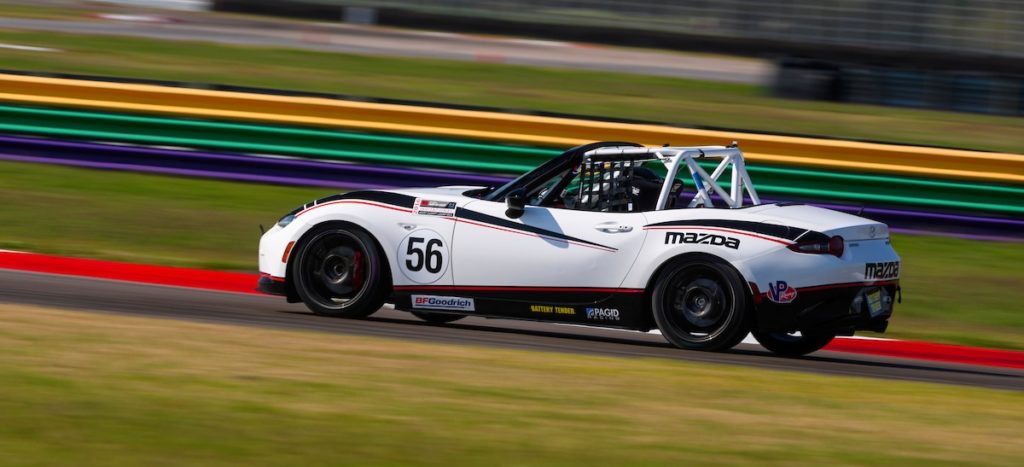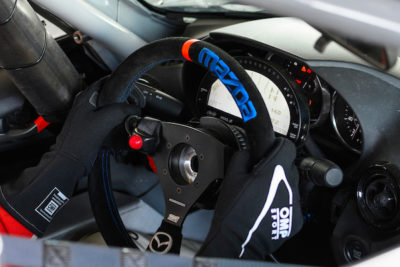Mazda’s support of its MX-5 Cup car goes beyond the quality of it build.
With more than 100 sales in the U.S. in about a year, plus sales to Europe, Asia, Australia and Canada, the MX-5 Cup car is largely considered one of the most successful launches of a new race car. The Idemitsu MX-5 Cup Series competitors have received the car well, with 56 different racers competing in the 2016 championship.
But one less known area where the MX-5 Cup car has been well received is track day organizations. Monticello Motor Club, for example, is considered “North America’s Premier Automotive Country Club and Private Race Track.” It’s closing in on 25 orders.
Based on feedback from our customers, we share the top 10 reasons the MX-5 Cup cars have been highly regarded by track day members. Let’s start with the six obvious ones:
1. Brand new, reliable Mazda car with advanced safety features. The race car starts as the 4th generation MX-5, which earned the World Car of the Year and the World Car Design of the Year awards. It’s then transitioned into a race car using competition racing components selected by Mazda Motorsports and vetted via Mazda Motorsports’ factory racing drivers and development partner Long Road Racing.
• A brand new race car means that when you plan your track day or weekend, you should be able to run all the sessions with no unexpected downtime due to failures.
• You should also consider your cost-to-own.
• But most important, when you’re making a decision to get on the race track, safety should be the #1 consideration. With the MX-5 Cup car, you receive modern safety standards. The cage, for example, has been engineered and verified by the FIA. Plus, we believe racers should work up to cars that go 175mph plus – for the good of their family, friends, and self.
2. Parity / A true spec car with equal performance (all too rare in racing). The formula starts with selecting all the competition parts components on the car because they are considered to be the best value. (Before the race car went to market, we leveraged computer testing, thousands of miles of on-track testing – many of which were in public – and now a season of racing.) Then, we seal key performance components: engine, ECU, dampers, transmission and more. To ensure it remains this way, the sanctioning bodies are educated and then perform compliance checks.
3. Fun to drive. Enjoy rolling speed into and out of corners? It’s the best entry level track car for learning and for developing advanced skills. The engineering put into the design makes it a great car for all levels of skill and provides a good amount of adjustment for setup.
4. Full parts support by Mazda for all components – one stop shopping and technical assistance. We sell both stock and competition parts at a special discount for this program through our competition parts department. Call 800.435.2508 for more information. And if you race in MX-5 Cup, you’ll know that the Long Road Racing crew supported each event with tech support and trailered a significant parts supply to support our racers.
5. Mazda contingency available if you decide to compete in NASA, SCCA, or with the Idemitsu MX-5 Cup. You can earn thousands of dollars for competing with this car, including the $200,000 scholarship if you won Idemitsu MX-5 Cup.
6. Continuous improvement. With an ETA of January 2017, Mazda Motorsports will offer a hard top. Our partner Long Road Racing will be offering a DOT tire from BFGoodrich® Tires.
What organizations such as Monticello Motor Club have figured out:
7. Competition and critical mass. When a club starts up a race series, the field can grow very quickly since the price to buy one is not $100K+ (it’s $58,900). Having an identical car that others have and run is how we learn. Want to compete against only a handful of racers or would you prefer to compete in large fields? In large fields, you will typically race someone and learn, rather than just do more lapping during a race. If you’re not interested in racing to get better, that’s okay. There are over 100 of these already participating in North America, which means it should not be hard to find others to compete against.
8. You may find some drivers and professional racing coaches willing to ride in the passenger seat with you while on track; just put a second seat in. Having a coach is recommended for development and safety. For those considering coaches, there are many with significant MX-5 experience (the most road-raced car in the world): Joel Miller, Tom Long, Andrew Carbonell, Kenton Koch, Stevan McAleer, Chad McCumbee, John Dean II and Robby Foley. Also, other types of cars that may have a more difficult or impossible time attracting ride-alongs due to their speed, single seats, or other factors.
9. Run it at track days, then jump into a sprint race with the SCCA in T3, NASA in PTC, or perhaps even a professional sprint race with the Idemitsu MX-5 Cup. If you want to continue to improve, you’ll have to keep running it against top competition.
10. Run it in an endurance race to maximize your learning from teammates, and the track time offered. Nicholas Evancich, for example, joined Drake Kemper (2015 Mazda Motorsports Scholarship driver), John Dean II (2016 Mazda Motorsports Scholarship driver), and Nathanial “Sparky” Sparks (2017 Mazda Motorsports Scholarship driver) for the VIRginia International Raceway 13 Hour endurance race on October 22 where they ran two MX-5 Cup cars, finishing in third and fourth positions, one second apart, out of 37 entries.



 ACCESSIBILITY
ACCESSIBILITY